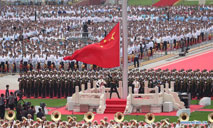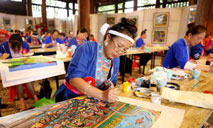China-Mexico historical ties witnessed by China-made coins
BEIJING, July 2 (Xinhua) -- At the first sight of the huge sculpture of a coin set in Jinggangshan in east China's Jiangxi Province, Diego Barroso, a Mexican language teacher based in Shanghai, wonders how the pattern of Latin America occurs on the China-made coins.
The coin, made by the Red Army Mint during the Chinese revolution, was engraved with an eagle with a snake in its mouth which is standing on a cactus growing between rocks in the lake. On the wings of the eagle engraved the Chinese character "Gong," which means workers. The picture is quite similar to the national emblem of Mexico.
To figure out the connection shown on coins between the two countries, Barroso came to Jinggangshan, the "cradle" of the Chinese revolution.
In 1928, in a bid to consolidate and develop revolutionary base areas, forefathers of the Communist Party of China (CPC) Mao Zedong and Zhu De with their army built the Red Army Mint in Jinggangshan, modeling the Mexican silver dollar to produce its own.
A professor from the China Executive Leadership Academy in Jinggangshan explained to Barroso why they chose Mexican money.
"During the late Qing Dynasty and the Republic of China (1912-1949) period, the Mexican silver dollar was one of the most used foreign money in southern and central China," said Wen Shangqing, an expert in the economic history of the CPC.
As early as in the colonial time, some well-known silversmiths in Mexico started to make silver coins and moulds, some of which circulated to other countries including China, said Javier Ocampo, a Mexican expert in local chronicles study.
"After the Red Army Mint opened, workers used silver and jewelry captured from the enemy to mint coins, on which they engraved the Chinese character 'Gong' to represent the government of workers, peasants and soldiers," said Li Haiquan, director of the Red Army Mint Site in Jinggangshan.
Mao emphasized the color and quality of the coins, asking the workers to use fine silver as raw materials, Li said.
The Mint had soon developed into one having dozens of workers with the capability of producing more than 400 coins in one stove each time, which gained a wide range of support and trust from people in the revolutionary base areas.
More than 10,000 coins had been made by the Mint in over six months since it was put in operation, and the flow of coins reached Jiangxi's counties along provincial boundaries like Yongxin and Suichuan.
After hearing the story on Mexican silver dollars' significant contribution in Jinggangshan during the Chinese revolution, Ocampo said, "I feel so proud as a Mexican."
Jin Jiadong, 70, is one of the very few who own a real coin produced by the Mint at that time.
About 93 years ago, two of Jin's uncles joined the Red Army and were later killed in battles.
"The coin was given by the army to express condolences to my family," said Jin, who was also a founder of the Jin Jiu Fu Coin Museum, a national museum located in Nanchang, Jiangxi. And the coin was cherished by his family members.
Wei Xiuchang, an official from the local financial supervisory department, said the Mint was a meaningful try and laid the foundation for the issuance of renminbi (RMB).
At the souvenir store of the Red Army Mint Site, Barroso bought a commemorative coin through digital payment, which made him reflect on the nearly a century of history after the Red Army Mint-made coin was born. Barroso was amazed by the rapid progress of China's money and finance industries.
With the continuously deepening of China's reform and opening up as well as the economic globalization, the RMB internationalization has been steadily promoted and is playing an increasingly important role in global trade, investment and financing.
The year 2021 marks the fifth year after RMB was added to the Special Drawing Rights basket of the International Monetary Fund (IMF).
According to the 2020 RMB Internationalization Report of the People's Bank of China, the size of renminbi reserves was the fifth-highest in the IMF's Currency Composition of the Official Foreign Exchange Reserves, with a market share of 1.95 percent, 0.88 percent higher than that in 2016 when the renminbi was included in the IMF's Special Drawing Rights currency basket. According to incomplete statistics, more than 70 central banks or monetary authorities incorporated RMB into their foreign exchange reserves.
Ray Dalio, founder of hedge fund Bridgewater Associates, said that RMB will play an increasingly significant role and be more and more widely used in the coming years, with more international trade and financial transactions being settled in RMB.
"I would like to share the stories of the coin with my daughter when I go back to Shanghai," Barroso said in front of the sculpture of the China-made coin.
Photos
Related Stories
- IPPA between Hong Kong, Mexico to enter into force on June 16
- China’s central bank to issue heart-shaped commemorative coins
- Mexico receives new shipment of COVID-19 vaccines from Chinese company Sinovac
- China to issue 2nd batch of 'Chinese master artisan' gold and silver commemorative coins
- China, Mexico pledge enhanced cooperation to promote ties
Copyright © 2021 People's Daily Online. All Rights Reserved.










